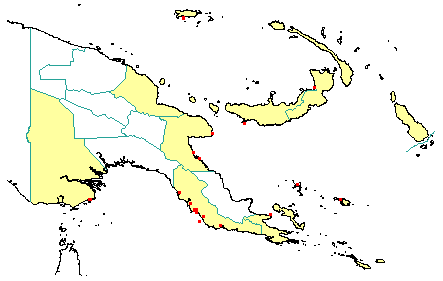
in PNGplants database
PNGTrees – Ceriops tagal (Perr.) C.B.Rob. |
Barry Conn (NSW) & Kipiro Damas (LAE).
Copyright held by the authors, Royal Botanic Gardens and Domain Trust, and Papua New Guinea National Herbarium
Philippine Journal of Science C. Botany Vol. 3: (1908)
Other Literature: M. Percival and J.S. Womersley, Floristics and Ecology of the Mangrove Vegetation of Papua New Guinea 58 (1975) Fig. 42-44.
Field Characters: Large trees up to 25 m high or small trees 2-8 m high, or shrub. Bole cylindrical up to 30 cm diam.; crooked gnarled and twisted, bole up to about 7 m long, but usually short (up to 1 m long) with plant often branching from near base or almost straight; buttresses present; spines absent; aerial roots present forming plank-like buttresses and frequently with knee-like roots present above soil surface; stilt roots absent. Bark reddish brown or grey, rough, pustular or fissured; lenticels elongated laterally reddih lenticels prominent on buttresses; subrhytidome red; blaze consisting of one layer; faintly to non-aromatic; outer blaze brownish pink, red, or brown, markings absent, fibrous; inner blaze brownish pink, red, or brown, markings absent, fibrous; exudate absent. Terminal buds not enclosed by leaves; complex hairs absent; stinging hairs absent; mature twig without hairs.
Leaves: Spaced along branches <internodes readily visible> or slightly clustered at end of branches <internodes indistinct>. Leaves opposite, simple; petiole present 8-40 mm long, not winged, attached to base of leaf blade <not peltate>, not swollen; lamina slightly broadest above middle or broadest at or near middle, 3.5-11.5 cm long, 1.5-5.0 (-7.5) cm wide; lamina symmetric, margin entire, not dissected or lobed, apex acuminate, rounded often with very short point, or obtuse, venation pinnate <secondary veins arising from the midrib along its length>, secondary veins open <spaced far apart to easily see tertiary veins>, not prominent, but visible or not visible, intramarginal veins absent; lower surface pale green or green, upper surface dark green, hairs absent; oil dots absent; domatia absent; stipules present, joined, joined across twigs <growing between opposite leaves and leaving a scar between them when they fall; interpetiolar>, not encircling the twig, leafy, not fringed, large <easily visible to the eye> 10-30 mm long, not persistent.
Flowers: Inflorescence axillary <from between a leaf and branch>. Flowers on a branched axis inflorescence of 2-12 flowers; flowers bisexual, stalked about 5 mm long, with many planes of symmetry <actinomorphic>, 6.0-10.0 mm long, small (< or =10 mm diam.) 6-8 mm diam.; perianth present, with distinct sepals and petals, white; inner perianth 5 (apex of each petal divided into a 3-part appendage), free or sometimes some or partly joined at base with hairs; stamens 10, filaments present, free of each other, free of perianth; ovary partly inferior <perigenous>, carpels joined (when more than one) <syncarpous> styles solitary <including joined together> 1-3 mm long, 1.
Fruits: Fruits arranged on branched axis but usually only one or two fruits developing on each axis. Fruit 12-25 mm long, 5.0-10.0 mm diam., fruit greenish brown, not spiny, non-fleshy leathery, simple, indehiscent, drupe the fruit does not fall with the hypocotyl. Seeds 1, not winged.
Distribution: Morobe, Central, Western, Madang, Bougainville, Manus, New Ireland, New Britain, Papuan Islands & Milne Bay.
 | Botanical records in PNGplants database |